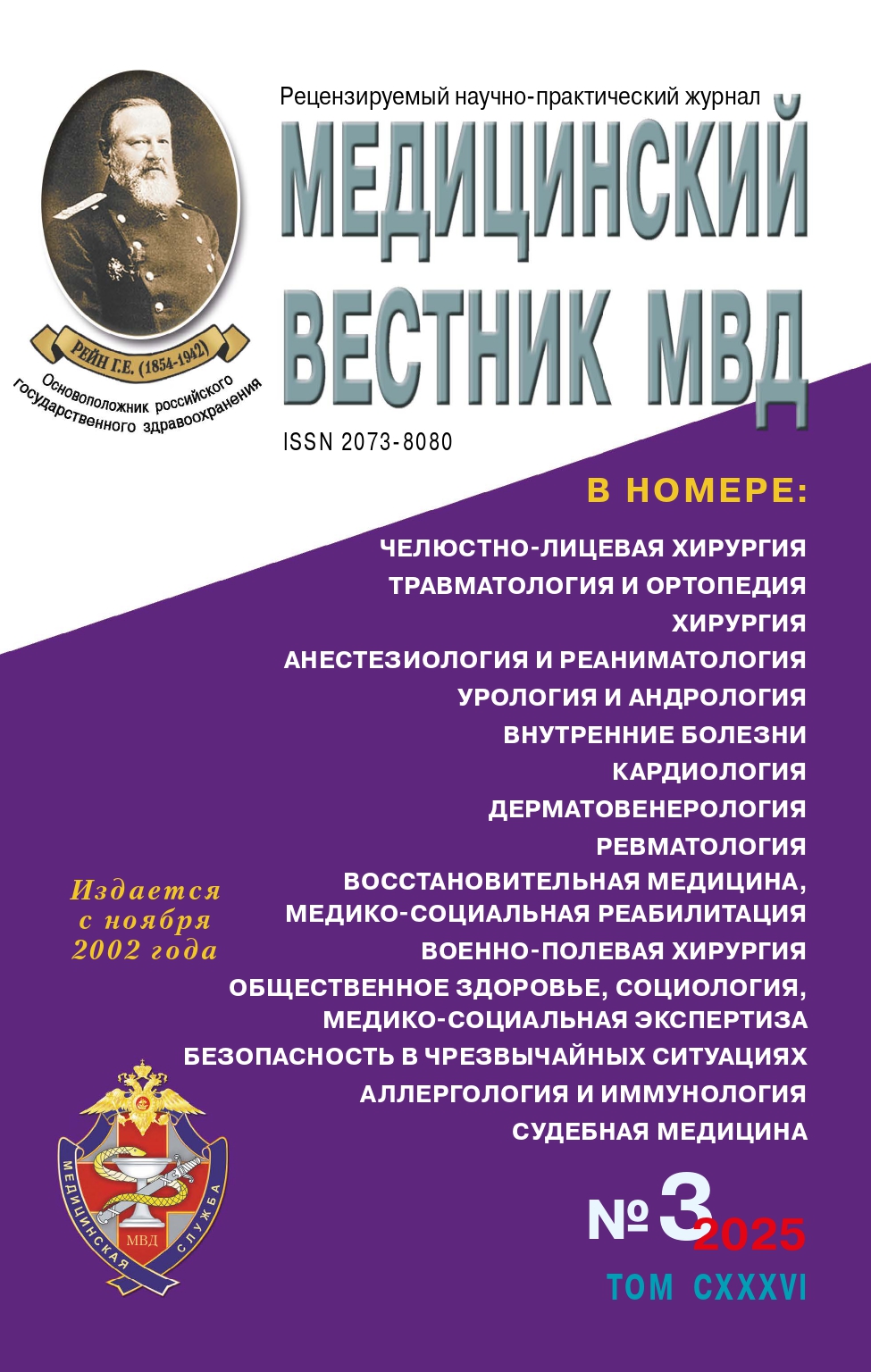Russian Federation
Federal State Budgetary Institution of Higher Professional Education "Central State Medical Academy" of the Presidential Executive Office of the Russian Federation (Department of Urology, Associate Professor)
Russian Federation
Russian Federation
Russian Federation
Russian Federation
VI-RADS protocol is used to standardize assessments of the magnetic resonance imaging of bladder and to improve preoperative planning in case of bladder cancer. VI-RADS helps to classify the tumors by the likelihood of invasion into muscular layer and to optimize the treatment tactics. Application of VIRADS makes it possible to reduce the numbe of invasive procedures, improve interdisciplinary interaction and ensure dynamic monitoring of the patients.
VI-RADS, bladder cancer, magnetic resonance imaging, transurethral resection, invasion into muscular layer, interdisciplinary interaction, laser resection, artificial intelligence
1. Rak mochevogo puzyrya. Klinicheskie rekomendacii. – 2022 – S. 9
2. Sostoyanie onkologicheskoy pomoschi naseleniyu Rossii v 2023 godu / Pod red. Kaprina A.D., Starinskogo V.V., Shahzadovoy A.O. // M.: MNIOI im. P.A. Gercena − filial FGBU «NMIC radiologii» Minzdrava Rossii. – M. – 2023; 13,18, 20-21.
3. Panebianco V., Narumi Y., Altun E. et al. Multiparametric magnetic resonance imaging for bladder cancer: development of VI-RADS (Vesical Imaging-Reporting And Data System) // Eur Urol. – 2018; 74(3):294-306. Doi:https://doi.org/10.1016/j.eururo.2018.04.029
4. Etxano J., Rodríguez-Vigil B., Pérez F. et al. Vesical Imaging-Reporting and Data System (VI- RADS®): Initial experience in the classification of muscle-invasive bladder cancer. Vesical Imaging- Reporting and Data System (VI-RADS®): experiencia inicial en la clasificación del cáncer de vejiga músculo-infiltrante // Actas Urol Esp (Engl Ed). – 2021; 45(4):320-325. Doi:https://doi.org/10.1016/j.acuro.2020.10.004
5. Ye L., Chen Y., Xu H. et al. Biparametric magnetic resonance imaging assessment for detection of muscle-invasive bladder cancer: a systematic review and meta-analysis // Eur Radiol. – 2022; 32(9):6480–6492. Doi:https://doi.org/10.1007/s00330-022-08696-5
6. Aslan S., Cakir I.M., Oguz U., Bekci T., Demirelli E. Comparison of the diagnostic accuracy and validity of biparametric MRI and multiparametric MRI-based VI-RADS scoring in bladder cancer; is contrast material really necessary in detecting muscle invasion?// Abdom Radiol (NY). – 2022; 47(2):771–780. Doi:https://doi.org/10.1007/s00261-021-03383-3
7. Del Giudice F., Barchetti G., De Berardinis E. et al. Prospective Assessment of Vesical Imaging Reporting and Data System (VI-RADS) and Its Clinical Impact on the Management of High-risk Non- muscle-invasive Bladder Cancer Patients Candidate for Repeated Transurethral Resection // Eur Urol. – 2020; 77(1):101–109. Doi:https://doi.org/10.1016/j.eururo.2019.09.029
8. Kural S., Pathak A.K., Singh S. et al. Prospective Assessment of VI-RADS with Muscle Invasion in Urinary Bladder Cancer and Its Implication on Re-Resection/Restaging TURBT Patients. Ann Surg Oncol. Published online November 4, 2024 Doi:https://doi.org/10.1245/s10434-024-16424-0
9. Hayashida Y., Miyata Y., Matsuo T. et al. A pilot study to assess the safety and usefulness of combined transurethral endoscopic mucosal resection and en-bloc resection for non-muscle invasive bladder cancer // BMC Urol. – 2019; 19(1):56. Doi:https://doi.org/10.1186/s12894-019-0486-0
10. Roupret M., Babjuk M., Compérat E. et al. Guidelines for the Management of Non-Muscle Invasive Bladder Cancer // Eur Urol. – 2021
11. Yanagisawa T., Mori K., Motlagh R.S. et al. En Bloc Resection for Bladder Tumors: An Updated Systematic Review and Meta-Analysis of Its Differential Effect on Safety, Recurrence and Histopathology // J Urol. – 2022; 207(4):754–768. Doi:https://doi.org/10.1097/JU.0000000000002444
12. Hu H., Zhou M., Yang B., Zhou S., Liu Z., Zhang J. A Systematic Review on the Role of Repeat Transurethral Resection after Initial en Bloc Resection for Non-Muscle Invasive Bladder Cancer // J Clin Med. – 2022; 11(17):5049. Doi:https://doi.org/10.3390/jcm11175049
13. Xu J., Xu Z., Yin H., Zang J. Can a reresection be avoided after initial en bloc resection for high-risk nonmuscle invasive bladder cancer? A systematic review and meta-analysis // Front Surg. – 2022; 9:849929. Doi:https://doi.org/10.3389/fsurg.2022.849929
14. Di Y., Li H., He C., Peng H. En-bloc transurethral resection vs. conventional transurethral resection for primary non-muscle invasive bladder cancer: A meta-analysis // Actas Urol Esp (Engl Ed). – 2023; 47(5):309–316. Doi:https://doi.org/10.1016/j.acuroe.2022.08.012
15. Huang H., Wang T., Ahmed M.G. et al. Retrograde en bloc resection for non-muscle invasive bladder tumor can reduce the risk of seeding cancer cells into the peripheral circulation // World J Surg Oncol. – 2020; 18(1):33. Doi:https://doi.org/10.1186/s12957-020-1808-0
16. Zhang D., Yao L., Yu S. et al. Safety and efficacy of en bloc transurethral resection versus conventional transurethral resection for primary nonmuscle-invasive bladder cancer: a meta- analysis // World J Surg Oncol. – 2020; 18(1):4. Doi:https://doi.org/10.1186/s12957-019-1776-4
17. O,Sullivan N.J., MacCraith E., Temperley H.C., Naughton A., Davis N.F. Standard Transurethral Resection vs Transurethral Laser Surgery for Bladder Cancer: A Systematic Review and Meta-Analysis Comparing Clinical Outcomes and Complications // J Endourol. – 2023; 37(3):304–315. Doi:https://doi.org/10.1089/end.2022.0328
18. Chai J.L., Roller L.A., Liu X. et al. Performance of VI-RADS in predicting muscle-invasive bladder cancer after transurethral resection: a single center retrospective analysis // Abdom Radiol (NY). – 2024; 49(5):1593–1602. Doi:https://doi.org/10.1007/s00261-024-04245-4





